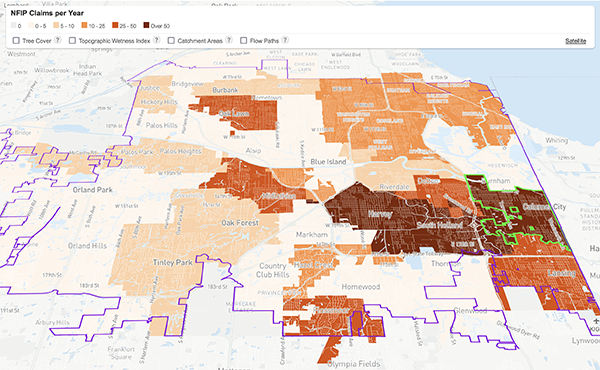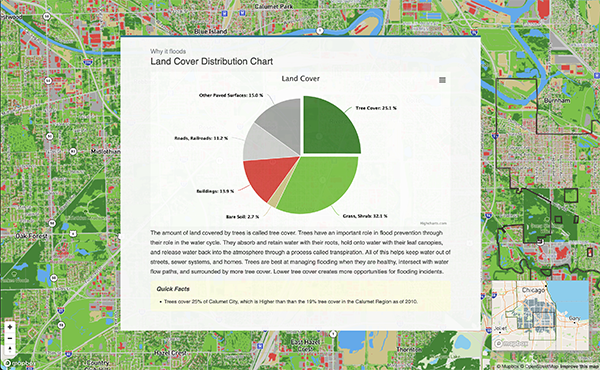Stormwater Photos
Select a community area or storm event to view photos:
Stormwater Stories
The stormwater photos included in this section have been taken by Calumet Region residents, who collected data from South Suburban communities, which include Dixmoor, Dolton, Harvey, Markham, Phoenix, Posen, Riverdale, and parts of Thornton Township. The photos were taken by the residents between March 2021 and May 2022 of the public rights of way via CNT’s app and then analyzed by CNT staff.
For each submission, data collectors documented how they believed stormwater would impact people and the infrastructure (roads, sidewalks, etc). CNT staff then categorized these storm event photos as no, low, high, or very high stormwater occurrences and analyzed resident responses. These categories were determined by the perceived volume of stormwater in each photo. For example, no stormwater meant there was very little to no water ponding, low meant few visible puddles, high looked like larger puddles pooling over infrastructure like a street or sidewalk, and very high looked like extensive pooling over infrastructure.
Data collectors shared similar concerns across the varying levels of stormwater occurrences. The main difference across the levels of stormwater occurrence was how frequently a data collector identified the particular concern, with higher levels of stormwater occurrence receiving a larger number of concerns. Data collectors also noted that a majority of the low stormwater occurrences posed minimal impact to residents.
Across the varying levels of stormwater occurrences, the concerns identified were:
- Limited access to infrastructure such as alleys, residential streets, parking lots, driveways, sidewalks, etc. This was especially prominent for the high and very high categories.
- Worse pedestrian experience. Some examples include pedestrians splashed by moving vehicles or difficulty crossing the street due to the amount of stormwater.
- Increased risky situations. Standing water reduced driver or pedestrian ability to see and navigate potholes or uneven sidewalks, making travel more difficult.
- Debris. Data collectors noticed instances in which debris was already blocking sewers, creating standing water and instances in which stormwater carried debris to block sewers. This could be a simple fix for municipalities to ensure that sewer covers remain clear.
- Public health and aesthetics. Residents noted that in even relatively low stormwater occurrences, they were concerned about mosquito or pest breeding grounds.
Concerns raised differed across the seasons, for example, stormwater in winter and early spring, made data collectors concerned about frozen puddles and ice blocking streets and alleys. Concerns for insects and pests were documented more during the warmer months. This sampling of photos and impacts on residents only begin to represent concerns that Calumet Region residents may have every time stormwater is not managed on public rights of way like streets and sidewalks.
The immense amount of flooding seen in the photos under the photo gallery does not only occur on the public walkways and streets. Major flooding indoors, which can be as high as knee-deep on occasion, has impacted a multitude of residents living in the Calumet River area.
"Each time the rain came the seepage came again and we have had several storms during the day."
-Resident from Blue Island
"It was a nightmare. It was our first experience with flooding, and we didn't know what to do."
-Resident from Chicago
Substantial amounts of flooding effecting residents are typically caused by heavy rain and severe storms. Flooding ranges from seepage into their basements to basements full of water. This flooding creates damaged property and major financial burdens from the costs of fixing the problem, remodeling the property, and installing flood mitigation products. Major flooding events can also cause high amounts of stress for the residents, which, in turn, results in mental health burdens as well.
"It affected us greatly because our storage area was flooded and before it began to mildew and mold we were like let's remove all the boxes from the storage and put them in the main basement. But we found a crack in the foundation and we [had] just moved in [on] May 7th, 2021. So the water issue is definitely a major problem."
-Lauren, resident from Dolton
During heavy storms, some residents are fortunate enough to not experience flooding in their basements. Other residents may only flood once and are able to find and afford adequate measures to prevent it from happening again. Meanwhile, other residents experience flooding on multiple occasions due to the lack of successful solutions to combat the flooding issues. This can cause significant burden on vulnerable households.
"It took hours for the seepage to stop and twice as many hours to clear the water. We had to haul items out to make room for the clean up. Humidity levels were extremely high in the house, several household items were destroyed."
-Gerard, resident from Dolton
"I was stressed out. We bought a utility pump to help pump out the water as it came in to stop it from covering the entire floor. [But] stressfully have to be home to work the pumps. [We] had to bleach the floor the next day."
-Dawn, resident from Blue Island
Solutions and preventive measures that some residents have taken in order to minimize the damage caused by floods include: installing sump pumps, raising the dirt surrounding the foundation of the house, keeping the gutters clear, installing utility pumps, installing an overhead basement sewer, having foundation cracks fixed, and having basement pipes rodded. These are just some of the ways residents can remain prepared for flooding and prevent any major damage. Other methods of preparation for flooding can be found in our Homeowner Flood Resources guide.
Residential flooding is extremely prevalent in the areas surrounding the Calumet River and hearing community members stories can help local governments develop community-level solutions that will positively impact residents.



